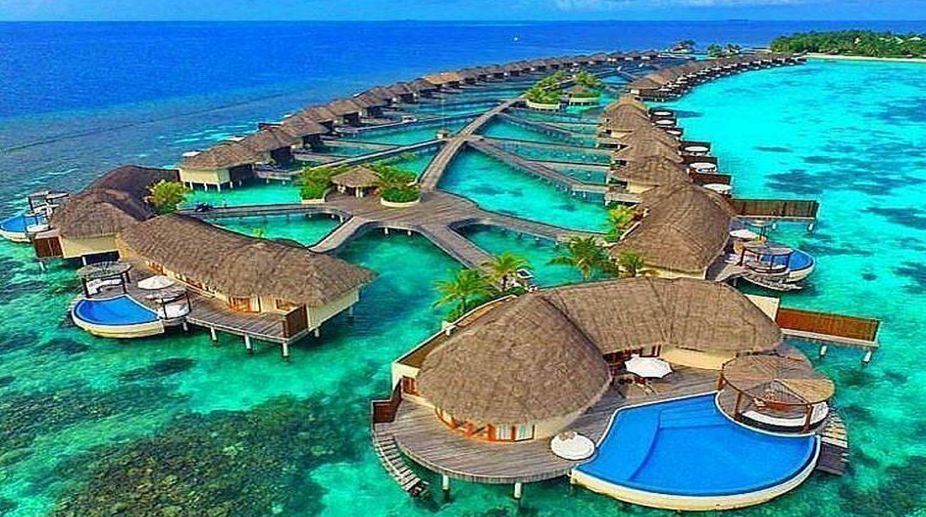India’s Gita Sabharwal appointed UN Resident Coordinator in Indonesia
India's Gita Sabharwal has been appointed as the United Nations Resident Coordinator in Indonesia, with the host Government's approval.

As the Sri Lankan Airlines' swanky new Airbus 320 cruises smoothly through cerulean skies over an aquamarine sea. I'm finding it tough to put my iPhone camera down. In between stuffing my face with finger-licking good food and quaffing worldclass wines served in the business class, I'm furiously clicking photos.
For right below me is a living moving landscape that's blowing my mind ~ the Maldives archipelago's 1,200 coral islands scattered like jewels in the ocean, white-gold sands with a turquoise trim, crystal clear waters and a burnished sun framed by a curtain of palms. The "garland islands" live up to their moniker and are draped like a necklace across the Indian Ocean, hanging below the tear dropshaped earring of Sri Lanka
The Maldives conjure up images of impossible beauty. Believe me, every bit of it is true. Having spent four sinful days there I should know! Though the Capital city of Male is usually where tourists drop anchor, I chose Gan Island, Maldives' biggest island located on Addu Atoll that is increasingly finding resonance with discerning travellers. This is also where the super-rich land in their private jets ~ 10 a month, on average.
Advertisement
There's a whiff of history in Gan's frangipani-scented air. From 1941 to 1976, it served as a strategic outpost for the British Navy and later the Royal Air Force.The English imprimatur is evident everywhere. There are still perfectly preserved buildings from the 30's and 40's on Gan: barrack-style, pale blue buildings where British soldiers were housed, and the Astra, an elegant Art Deco cinema that still runs movies. Gan is connected to its neighbouring islands by a 22-km road, the longest in the Maldives.
My abode in Gan, Canareef Resort, sprawls over 4.5 km and comes accoutred with a decadent spa, a bar, two restaurants showcasing global cuisines and offers a host of water-based activities. Snorkel, dive, fish, sail. However, rather than go for these high-octane activities, I plump for immersive cultural experiences that allow me an insight into this intriguing country of 400,000 people. I try authentic local cuisine, island hop, engage with the warm and friendly Maldivians…. My guides Saeed and Firaq, a trove of knowledge, keep me hooked with their engaging narrations while also teaching me a smattering of Dhivehi, a mix of Arabic, Urdu and Sinhalese.
Exotic flora and fauna
The Maldives ~ though Asia's smallest country ~ are covered with dense vegetation. While the island's leitmotif is the picturesque droopy palm, other plants grow plentifully ~ breadfruit, plantain, papaya, mango, coconut…The gargantuan banyan tree, also known as strangler fig or Nika, grows abundantly. Ornamental plants, such as bougainvilleas, hibiscuses and frangipanis also thrive. On many islands, also about 10m high screw pine have settled with their typical stilt roots, which grow perpendicular to the ground to support the branches. Its fruits are similar in size and appearance of a pineapple. They change colour to red as they ripen and are eaten cooked.
Due to the island's compact size, wildlife habitat is limited. The hermit crab is one of the best known species of crustaceans found here.There are also geckos, bats, a Maldivian subspecies of the Indian flying fox, which hang upside down in the high treetops. The birds include the Maldivian crow, heron, koel, as well as gulls, terns and frigate birds occasionally.
However, the Maldivian flora and fauna underwater is one of the most breathtaking; an inexhaustible variety of species and colours. Inland lagoons and coastal reefs brim with tropical ocean fish, crustaceans, and turtles. The surrounding waters contain sharks, swordfish, and porpoises. The Maldives are also considered the richest fishing grounds in the world and its coral reefs are among the greatest.
Dolphin spotting
One of the greatest joys of the Maldives are its little spinner dolphins. They earn their names for their antics: in the late afternoon, as they make their way out of the lagoons and into the deep ocean to hunt, they leap into the air to spin playfully. Friendly that they are, the fat fellows will happily follow your boat! So make sure to book a dolphin spotting tour. Maldives is home to several species of dolphins, including Spinners, BottleNosed dolphins and pilot whales. If you have time, go for the Maldives' marine Big Five: manta and eagle rays, sea turtles, dolphins and sharks, including whale sharks.
Feast of flavours
Maldivian cuisine is a feast of flavours. Local chefs leverage the region's fresh sea produce, vegetables and fruits to craft tasty treats. I tuck into an array of authentic Maldivian dishes during my stay. While super-spicy tuna curry tops the menu, maas roshi (tuna and coconut patties) and kaashi bokibaa (coconut, rosewater and palm sugar balls) are to die for. At Suvadive Cafe in Addu, I feast on soulful Sri Lankan curry with rice and a pot-roasted chicken with crispy skin. Dessert was a sinful tiramisu. All was washed down with the famous Maldivian lemonade. Joy!
For a true blue Maldivian food experience, try to eat at a local home for this is where the real culinary treasures are. I was fortunate to be invited to a local Maldivian home on Addu atoll for a fulsome feast. There was steamed breadfruit and bananas, boiled yam and papayas, grilled parrot fish, wahu and tuna. Dessert was Bondiba, a delicious confection of rice, palm sugar, rose petals and jasmine water compressed into laddus. The flavours still dance on my palate!
The writer is a Delhi-based journalist
Advertisement